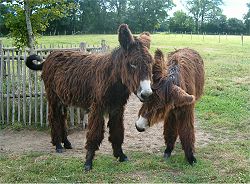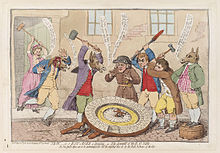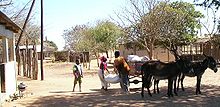- Donkey
-
For other uses, see Donkey (disambiguation).
Donkey 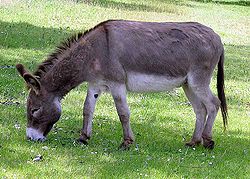
Conservation status DomesticatedScientific classification Kingdom: Animalia Phylum: Chordata Class: Mammalia Order: Perissodactyla Family: Equidae Genus: Equus Subgenus: Asinus Species: E. africanus Subspecies: E. africanus asinus Trinomial name Equus africanus asinus
Linnaeus, 1758The donkey or ass, Equus africanus asinus,[1][2] is a domesticated member of the Equidae or horse family. The wild ancestor of the donkey is the African Wild Ass, E. africanus. In the western United States, a small donkey is sometimes called a burro (from the Spanish word for the animal).
A male donkey or ass is called a jack, a female a jenny, and an offspring less than one year old a foal (male: colt, female: filly).
While different species of the Equidae family can interbreed, offspring are almost always sterile. Nonetheless, horse/donkey hybrids are popular for their durability and vigor. A mule is the offspring of a jack (male donkey) and a mare (female horse). The much rarer successful mating of a male horse and a female donkey produces a hinny.
Asses were first domesticated around 3000 BC,[3] or 4000 BC, probably in Egypt or Mesopotamia,[4] and have spread around the world. They continue to fill important roles in many places today. While domesticated species are increasing in numbers, the African wild ass and another relative, the Onager, are endangered. As "beasts of burden" and companions, asses and donkeys have worked together with humans for millennia.
Contents
Scientific and common names
Traditionally, the scientific name for the donkey is Equus asinus asinus based on the principle of priority used for scientific names of animals. However, the International Commission on Zoological Nomenclature ruled in 2003 that if the domestic species and the wild species are considered subspecies of each other, the scientific name of the wild species has priority, even when that subspecies was described after the domestic subspecies.[2] This means that the proper scientific name for the donkey is Equus africanus asinus when it is considered a subspecies, and Equus asinus when it is considered a species.
Until recently the synonym ass was the more common term for the donkey, as in jackass, meaning "male donkey". The first written use of donkey is as recent as 1785.[5] While the word ass has cognates in most other Indo-European languages, donkey is an etymologically obscure word for which no credible cognate has been identified. Hypotheses on its derivation include the following:
- Perhaps a diminutive of dun (dull grayish-brown), a typical donkey colour.[5][6]
- Perhaps from the name Duncan.[5][7]
- Perhaps of imitative origin.[7]
The homonymity in the United States with a vulgar term ass for "buttocks" may have influenced its gradual replacement by donkey there, though this does not account for the parallel change in Britain and Australia.[citation needed]
Characteristics
Donkeys vary considerably in size, depending on breed and management. The height at the withers ranges from 80 to 160 cm (31 to 63 in), and the weight from 80 to 480 kg (180 to 1060 lb). Donkeys have a lifespan of 30 to 50 years.[8]
Donkeys are adapted to marginal desert lands, and have many traits that are unique to the species as a result. Wild donkeys live separated from each other, unlike tight wild horse and feral horse herds. Donkeys have developed very loud vocalizations, which help keep in contact with other donkeys over the wide spaces of the desert. The best-known call is referred to as a "bray," which can be heard for over three kilometers. Donkeys have larger ears than horses. Their longer ears may pick up more distant sounds,[citation needed] and may help cool the donkey's blood. Donkeys in the wild can defend themselves with a powerful kick of their hind legs as well as by biting and striking with their front hooves.
Breeding
Jennies are normally pregnant for about 12 months, though the gestation period varies from 11 to almost 14 months.[9] Jennies usually give birth to a single foal. Twins are very rare: only about 1.7 percent of donkey pregnancies result in twins, and both twins survive in only about 14 percent of cases.[citation needed]
Nutrition
Donkeys' tough digestive system is somewhat less prone to colic than that of horses, can break down near-inedible vegetation and extract moisture from food very efficiently. As a rule, donkeys need smaller amounts of feed than horses of comparable height and weight. Because they are easy keepers, if overfed, donkeys are also quite susceptible to laminitis.
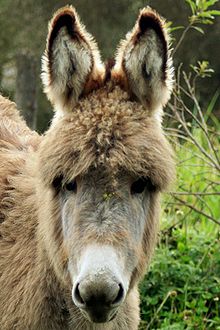 Woolly paramo donkey
Woolly paramo donkey
Donkeys evolved to spend 14–16 hours per day browsing and foraging for food. In their native arid and semi-arid climates this would often be a poor quality, scrubby fiber. Domesticated donkey owners face the challenge of feeding their donkey enough low energy fiber in order to meet their appetite, but in temperate climates the forage available is often too rich and abundant, resulting in weight gain and obesity with further implications including laminitis, hyperlipidemia and gastric ulcers.[10] Although the donkey’s gastrointestinal tract has no marked differences in structure to that of the horse, it is well documented that "donkeys are more efficient at digesting food than horses and, as a consequence, can thrive on less forage than a similar sized pony".[11] Donkeys need to eat approximately 1.5 percent of their body weight per day in dry matter,[12] compared with 2-2.5 percent for horses. It is not fully understood why donkeys are such efficient digestors but it is thought that they may have a different microbial population in the large intestine than do horses. Another possibility is increased gut retention time compared to ponies.[13]
Donkeys gain most of their daily energy needs from structural carbohydrates. An average, healthy donkey only requires free choice feeding of low-calorie fiber-rich forage such as straw (preferably barley straw), supplemented with controlled grazing in the summer and hay in the winter. A donkey’s requirement for protein and fat are so low that in practice once the energy requirements are met so too are the protein and fat requirements.[12] Cereal based feeds designed for horses are often too high in energy levels and will exceed the daily requirements of donkeys.[10] Even a small amount of grazing or fresh fodder during the spring and summer will provide adequate vitamin levels, so for a normal, healthy donkey a diet of straw plus a little grazing or hay meets their nutritional needs without need for concentrated feeds. A low-calorie vitamin and mineral supplement is recommended for donkeys year-round when on a restricted diet, and to all donkeys during the winter months.
Behaviour
Donkeys have a notorious reputation for stubbornness, but this has been attributed to a much stronger sense of "self preservation" than exhibited by horses.[14] Likely based on a stronger prey instinct and a weaker connection with man, it is considerably more difficult to force or frighten a donkey into doing something it perceives to be dangerous for whatever reason. Once a person has earned their confidence they can be willing and companionable partners and very dependable in work.[citation needed]
Although formal studies of their behaviour and cognition are rather limited, donkeys appear to be quite intelligent, cautious, friendly, playful, and eager to learn.
Communication
Braying is the characteristic sound made by an ass, donkey, and most mules. Donkeys use this sound to communicate and will bray more frequently when a new donkey is encountered. The sound typically lasts for twenty seconds.[15][16] The sound may be rendered onomatapoeically as "eeyore" and so this was used as the name of the donkey in Winnie-the-Pooh. Donkeys may be trained to bray or not to bray upon command. This may be used as a form of mockery.[17][18] Braying may be considered a simile for loud and foolish speech. For example,[19]
There are braying men in the world as well as braying asses; for what's loud and senseless talking and swearing, any other than braying—Sir Roger L'EstrangeHistory
 Donkey in an Egyptian painting c. 1298-1235 BC
Donkey in an Egyptian painting c. 1298-1235 BC
The ancestors of the modern donkey are the Nubian and Somalian subspecies of African wild ass.[20][21] Remains of domestic donkeys dating to the fourth millennium BC have been found in Ma'adi in Lower Egypt, and it is believed that the domestication of the donkey was accomplished long after the domestication of cattle, sheep and goats in the seventh and eighth millennia BC. Donkeys were probably first domesticated by pastoral people in Nubia, and they supplanted the ox as the chief pack animal of that culture. The domestication of donkeys served to increase the mobility of pastoral cultures, having the advantage over ruminants of not needing time to chew their cud, and were vital in the development of long-distance trade across Egypt. In the Dynasty IV era of Egypt, between 2675 and 2565 BC, wealthy members of society were known to own over 1,000 donkeys, employed in agriculture, as dairy and meat animals and as pack animals.[22] In 2003, the tomb of either King Narmer or King Hor-Aha (two of the first Egyptian pharaohs) was excavated and the skeletons of ten donkeys were found buried in a manner usually used with high ranking humans. These burials show the importance of donkeys to the early Egyptian state and its ruler.[23]
By the end of the fourth millennium BC, donkey had spread to Southwest Asia, and the main breeding center had shifted to Mesopotamia by 1800 BC. The breeding of large, white riding asses made Damascus famous, while Syrian breeders developed at least three other breeds, including one preferred by women for its easy gait. The Muscat or Yemen ass was developed in Arabia. By the second millennium BC, the donkey was brought to Europe, possibly at the same time as viticulture was introduced, as the donkey is associated with the Syrian god of wine, Dionysus. Greeks spread both of these to many of their colonies, including those in what are now Italy, France and Spain; Romans dispersed them throughout their empire.[22]
The first donkeys in the New World arrived in 1495 on a supply ship to Christopher Columbus, with four jacks and two jennies in the cargo delivered to Hispaniola. These were used to breed mules for expeditions to mainland America, with males preferred for pack animals and the females for riding. The first shipment of mules, including three jacks and twelve jennies, arrived in Mexico from Cuba ten years after the conquest of the Aztecs. Mules were used in silver mines, and each Spanish outpost in the empire bred its own mules from its own jack. Donkeys arrived in large numbers in the western United States during the nineteenth century gold rushes, as pack animals and for use in mines and ore-grinding mills. The major use of donkeys came to an end with the end of the mining boom and the introduction of railroads in the West. With little value, many animals were turned loose to become the populations of free-roaming donkeys that inhabit the West today.[22]
Miniature donkeys originally developed on Sicily and Sardinia in the Mediterranean, but are now almost extinct on those islands. Breeders in the United States have spent decades breeding what they term the Miniature Mediterranean Donkey, a mix of Sicilian and Sardinian strains, following the establishment of a breed registry in 1958.[24] Large, draft-type donkeys originated with the Andalusian-type donkey, and today are seen in the United States as the American Mammoth Jack, a mix of many other donkey breeds.[25]
As of 2007 there were estimated to be around 44 million donkeys worldwide. The majority of these are used for agriculture and transportation, although most donkeys in the US (a population of about 55,000, about half of which are Miniature donkeys) are used for recreation or as pets.[26] Donkeys are increasing in popularity in Canada and the US, where they are used as pack animals, riding animals and for pulling wagons. They are also used to halterbreak calves and as guard animals for flocks of sheep, protecting them from coyotes and dogs.[22] According to British food writer Matthew Fort, donkeys were, until recently, used in the Italian Army. The Mountain Fusiliers each had a donkey to carry their gear, and in extreme circumstances the animal could be eaten.[27] They have also been used to carry explosives in conflicts that include the war in Afghanistan and others.[28][29] Some cultures that prohibit women from working with oxen in agriculture do not extend this taboo to donkeys. allowing them to be used by both sexes.[30]
Present status
About 41 million donkeys were reported worldwide in 2006.[31] China has the most with 11 million, followed by Pakistan, Ethiopia and Mexico. Some researchers believe the actual number is somewhat higher since many donkeys go uncounted.[32] The number of breeds and percentage of world population for each of the FAO's world regions was in 2006:[31]
Region No. of breeds % of world pop. Africa 26 26.9 Asia & Pacific 32 37.6 Europe & the Caucasus 51 3.7 Latin America & the Caribbean 24 19.9 Near & Middle East 47 11.8 North America 5 0.1 World 185 41 million head In 1997 the number of donkeys in the world was reported to be continuing to grow, as it had steadily done throughout most of history; factors cited as contributing to this were increasing human population, progress in economic development and social stability in some poorer nations, conversion of forests to farm and range land, rising prices of motor vehicles and fuel, and the popularity of donkeys as pets.[32][33] More recently, the world population of donkeys is reported to be rapidly shrinking, falling from 43.7 million to 43.5 million between 1995 and 2000, and to only 41 million in 2006.[31]
The Domestic Animal Diversity Information System (DAD-IS) of the FAO listed 189 breeds of ass in June 2011.[34] In 2000 the number of breeds of donkey recorded worldwide was 97, and in 1995 it was 77. The rapid increase is attributed to attention paid to identification and recognition of donkey breeds by the FAO's Animal Genetic Resources project.[31]
See also: List of donkey breedsIn prosperous countries, the welfare of donkeys both at home and abroad has recently become a concern, and a number of sanctuaries for retired and rescued donkeys have been set up. The largest is the Donkey Sanctuary of England, which also supports donkey welfare projects in Egypt, Ethiopia, India, Kenya, and Mexico.[35]
Economic use
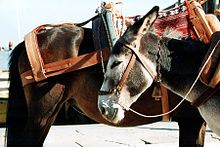 On the island of Hydra, because cars are outlawed, donkeys and mules form virtually the sole method of heavy goods transport.
On the island of Hydra, because cars are outlawed, donkeys and mules form virtually the sole method of heavy goods transport.
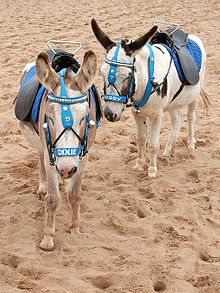
Classic British seaside donkeys in SkegnessThe vast majority of donkeys are used for the same types of work that they have been doing for 6000 years. Their most common role is for transport, whether riding, pack transport, or pulling carts. They may also be used for farm tillage, threshing, raising water, milling, and other jobs. Other donkeys are used to sire mules, as companions for horses, to guard sheep, and as pets. In the past, donkey skin was used in the production of parchment.[31]
A few donkeys are milked or raised for meat;[32] in Italy, which has the highest consumption of equine meat in Europe and where donkey meat is the main ingredient of several regional dishes, only about 1000 donkeys were slaughtered in 2010, yielding approximately 100 tonnes of meat.[36] Asses' milk may command good prices: the average price in Italy in 2009 was €15 per litre,[37] and a price of €6 per 100 ml was reported from Croatia in 2008; it is used for soaps and cosmetics as well as dietary purposes. The niche markets for both milk and meat are expanding.[31]
Donkey cart being loaded in Mapai, Mozambique
Donkeys are often pastured or stabled with horses and ponies, and are thought to have a calming effect on nervous horses. If a donkey is introduced to a mare and foal, the foal will often turn to the donkey for support after it has been weaned from its mother.[38]
Donkeys are now commonly[citation needed] kept as pets in countries where their use as beasts of burden has disappeared. Donkey rides for children are also a popular[citation needed] pastime for children in holiday resorts or other leisure contexts.
Shoeing
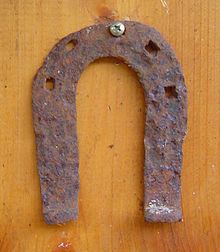
A donkey shoe with calkins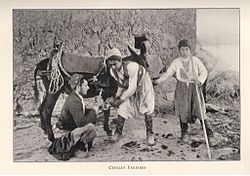
Farriers shoeing a donkey in Cyprus in 1900Working donkeys may need to be shod. Donkey shoes are similar to horseshoes, but usually smaller and without toe-clips.
Feral donkeys and wild asses
In some areas domestic donkeys have returned to the wild and established feral populations, such as the Burro of North America and the Asinara donkey of Sardinia, Italy, both of which have protected status. Feral donkeys can also cause problems, notably in environments that have been evolutionarily free of any form of equid, such as Hawaii.[39] In Australia, where there may be 5 million feral donkeys,[40] they are regarded as an invasive pest and have a serious impact on the environment. They may compete with livestock and native animals for resources, spread weeds and diseases, foul or damage watering holes and cause erosion.[41]
Wild asses, onagers, and kiangs
With the domestication of almost all donkeys, few species now exist in the wild. They include the African Wild Ass, Equus africanus, and its critically endangered subspecies the Somali Wild Ass, Equus africanus somaliensis, and Nubian Wild Ass, Equus africanus africanus, the principal ancestor of the domestic donkey.[31] Extinct species include the European Ass, Equus hydruntinus, which became extinct during the Neolithic, and the North African Wild Ass, Equus africanus atlanticus, which became extinct in Roman times.[31]
There are also five subspecies of Asiatic Wild Ass or Onager, Equus hemionus, and three subspecies of the kiang, Equus kiang, of the Himalayan upland.
In the wild asses can reach top speeds equalling zebras and even most horses.
Donkey hybrids
A male donkey (jack) can be crossed with a female horse to produce a mule. A male horse can be crossed with a female donkey (jennet or jenny) to produce a hinny. A female donkey in the UK is called a mare, or jenny.
Horse-donkey hybrids are almost always sterile because horses have 64 chromosomes whereas donkeys have 62, producing offspring with 63 chromosomes. Mules are much more common than hinnies. This is believed to be caused by two factors, the first being proven in cat hybrids, that when the chromosome count of the male is the higher, fertility rates drop (as in the case of stallion x jennet).[citation needed] The lower progesterone production of the jenny may also lead to early embryonic loss. In addition, there are reasons not directly related to reproductive biology. Due to different mating behavior, jacks are often more willing to cover mares than stallions are to breed jennys. Further, mares are usually larger than jennys and thus have more room for the ensuing foal to grow in the womb, resulting in a larger animal at birth. It is commonly believed that mules are more easily handled and also physically stronger than hinnies, making them more desirable for breeders to produce, and it is unquestioned that mules are more common in total number[citation needed].
The offspring of a zebra-donkey cross is called a zonkey, zebroid, zebrass, or zedonk;[42] zebra mule is an older term, but still used in some regions today. The foregoing terms generally refer to hybrids produced by breeding a male zebra to a female donkey. Zebra hinny, zebret and zebrinny all refer to the cross of a female zebra with a male donkey. Zebrinnies are rarer than zedonkies because female zebras in captivity are most valuable when used to produce full-blooded zebras.[43] There are not enough female zebras breeding in captivity to spare them for hybridizing; there is no such limitation on the number of female donkeys breeding.
Cultural references
 A North African donkey in a 1917 issue of National Geographic Magazine
A North African donkey in a 1917 issue of National Geographic Magazine
The long history of human donkey use has created a rich store of cultural references:
Religion, myth and folklore
Donkeys (or asses) are mentioned many times in the Bible, beginning in the first book and continuing through both Old and New Testaments. They are generally seen as work animals, used for agricultural purposes, transport and as beasts of burden, and terminology is used to differentiate age and gender. In contrast, horses were shown in use only in the context of war - ridden by the cavalry or pulling chariots. Owners were protected by law from loss caused by the death or injury of a donkey, showing their value in that time period. Narrative turning points in the Bible (and other stories) are often marked through the use of donkeys - for instance, leading, saddling, or mounting/dismounting a donkey are used to show a change in focus or a decision having been made.[44] They are used as a measure of wealth in Genesis 30:43,[45] and in Genesis chapter 34, the prince of Shechem (the modern Nablus) is named Hamor ("donkey" in Hebrew).[46] The cross-shaped marking present on donkeys' backs and shoulders supposedly celebrates the animal bearing Jesus into Jerusalem on Palm Sunday, and hairs from this cross (or contact with a donkey) were used as folk remedies to cure illness, including measles and whooping cough.[47] Around 1400 AD, one physician listed riding backwards on a donkey as a cure for scorpion stings.[48] As well as being associated with Jesus, the donkey was also the symbol of the Egyptian god Ra and the Greek god Dionysus.[49]
Donkeys also appear repeatedly in the Hindu and Islamic religions. In Hinduism, the goddess Kalaratri's vahana (vehicle) is a donkey.[50] Muhammad, the prophet of Islam said that dogs and donkeys, if they pass in front of men in prayer, will void or nullify that prayer.[51] He also said that "when you hear the braying of donkeys, seek Refuge with Allah from Satan for (their braying indicates) that they have seen a devil."[52] Donkeys also appear multiple times in Indian folklore as the subject of stories in both the Hitopadesha[53] and the Panchatantra.[54]
In the Jewish religion, donkeys are considered avi avot hatuma or the ultimate impure animal. They are considered doubly "impure", as they are both non-ruminants and non-cloven hoofed. However, they are the only impure animal that is falls under the mitzvah (commandment) of firstborn consecration that also applies to humans and pure animals. In Jewish Oral Tradition, the son of David was prophesied as riding on a donkey if the tribes of Israel are undeserving of redemption.[55] In contemporary Israel, the term "Messiah's Donkey" (Chamoro Shel Mashiach חמורו של משיח) stands at the center of a controversial religious-political doctrine, under which it was the Heavenly-imposed "task" of secular Zionists to build up a Jewish State, but once the state is established they are fated to give place to the Religious who are ordained to lead the state. The secularists in this analogy are "The Donkey" while the religious who are fated to supplant them are a collective "Messiach". A book on the subject, published in 1998 by the militant secularist Sefi Rechlevsky, aroused a major controversy in the Israeli public opinion.[56]
Literature and film
Donkeys hold a significant place in literature, especially in Western cultures. The original representations of donkeys in Western literature come mainly from the Bible and Ancient Greece. Donkeys were represented in a fairly negative form by the Greeks, but perceptions later changed, partially due to donkeys becoming increasingly symbolically connected to Christianity. Donkeys were found in the works of Homer, Aesop and Apuleius, where they were generally portrayed as stupid and stubborn, or servile at best, and generally represented the lower class. They were often contrasted with horses, which were seen as powerful and beautiful. Aesop's The Ass in the Lion Skin, representational of the almost 20 of his fables that portray donkeys, shows the donkey as a fool. Apuleius's The Golden Ass (160 AD), where the narrator is turned into a donkey, is also notable for its portrayal of donkeys as stubborn, foolish, wicked and lowly. This work had a large influence on the portrayal of donkeys in later cultures, including medieval and renaissance Europe. During this time, donkeys continued to be shown as stupid, clumsy and slow. Shakespere popularized the use of the word "ass" as an insult meaning stupid or clownish in many of his plays, including Bottom's appearance in A Midsummer Night's Dream (1600). In contrast, a few years later, Cervantes' Don Quixote shows a more positive slant on the donkey, portraying them as steady and loyal companions. This difference is possibly due to donkeys being an important aspect of many Spaniards' lives at this point in time.[57]
In contrast to Grecian works, donkeys were portrayed in Biblical works as symbols of service, suffering, peace and humility, most notably in their inclusion in the New Testament Nativity narrative. Donkeys are also associated with the theme of wisdom in the Old Testament story of Balaam's ass, and are seen in a positive light through the story of Jesus riding into Jerusalem on a donkey. By the 19th century, the donkey was beginning to be seen with more favoritism by popular authors. William Wordsworth portrayed the donkey as loyal and patient in his 1819 poem Peter Bell, using the donkey as a Christian symbol. However, in Robert Louis Stevenson's 1879 Travels with a Donkey, the animal is seen by the narrator as no more than a stubborn beast of burden. Sympathetic portrayals return in Juan Ramon Jimenez's Platero and I and the melancholy Eeyore in Winnie the Pooh (first release in 1926) is arguably the most famous donkey in Western literature. Donkeys continue to appear in literature during the 20th century, including in George Orwell's 1951 Animal Farm, where Benjamin the donkey is portrayed as resilient and loyal.[57] Portrayals at this time were not always positive however, as with the well-meaning but easily manipulated donkey Puzzle in C. S. Lewis's 1956 The Last Battle.[58] They also began to appear in film at this time, including the 1940 Disney film Fantasia, where the donkey is portrayed as a slapstick character who participates in a social faux pas with Bacchus and is punished by Zeus.[59] A donkey is the main character in the 1966 film Au hasard Balthazar by Robert Bresson, and, though a true donkey, follows a life path of Christian symbolism.[57] A donkey (named, aptly, Donkey and voiced by Eddie Murphy) also appears as a main character in the 2000's Shrek franchise.[60]
Colloquialisms, proverbs and insults
Many cultures have colloquialisms and proverbs that include donkeys or asses. American ones include "better a donkey that carries me than a horse that throws me", "a donkey looks beautiful to a donkey", and "a donkey is but a donkey though laden with gold", among others.[61] British phrases include "to talk the hind legs off a donkey", used to describe someone talking excessively and generally persuasively.[62] Donkeys are the animals seen most often in Greek proverbs, including such statements of fatalistic resignation as "the donkey lets the rain soak him".[63] French philosopher Jean Buridan constructed the paradox called Buridan's ass, in which a donkey, placed exactly midway between water and food, would die of hunger a thirst because he could not find a reason to choose one of the options over the other, and so would never make a decision.[64] Italy also has several phrases regarding donkeys, including "put your money in the ass of a donkey and they'll call him sir" (meaning, if you're rich, you'll get respect) and "women, donkeys and goats all have heads" (meaning, women are as stubborn as donkeys and goats).[65]
The words "donkey" and "ass" (or translations thereof) have come to have derogatory or insulting meaning in several languages, and are generally used to mean someone who is obstinate, stupid or silly,[66][67][68][69] In football, especially in the United Kingdom, a player who is considered unskilful is often dubbed a "donkey",[66] and the term has a similar connotation in poker.[70] In the US, the slang terms "dumbass" and "jackass" are used to refer to someone considered stupid.[71][72]
Politics
Donkeys feature in political systems, symbols and terminology in many areas of the world. A "donkey vote" is a vote that simply writes down preferences in the order of the candidates (1 at the top, then 2, and so on), and is most often seen in countries with preferential voting and compulsory voting such as Australia.[73] The donkey is a common symbol of the Democratic Party of the United States, originating in a cartoon by Thomas Nast of Harper's Weekly.[74] The "ruc català" or "burro català" (Catalan donkey) is a relatively recent symbol of Catalonia. It was chosen when the need was felt in Catalonia to produce something genuinely Catalan to oppose to the Spanish Osborne bull. The bull was perceived by Catalans as a centralistic symbol of Castile, alien to their culture.[75]
See also
- Asses' milk
- Burro Racing
- Exploding donkey
- Jennet, a type of medieval horse
- Onolatry
- Ponui donkey
- Safe Haven for Donkeys in the Holy Land
Further reading
- Fairman, Tony (2008). "How the ass became a donkey". English Today 10 (4): 29. doi:10.1017/S0266078400007860. ISSN 0266-0784.
References
- ^ Don E. Wilson & DeeAnn M. Reeder, ed (2005). "Equus asinus". Mammal Species of the World. A Taxonomic and Geographic Reference (3rd ed.). Johns Hopkins University Press. http://www.bucknell.edu/msw3/browse.asp?s=y&id=14100004.
- ^ a b International Commission on Zoological Nomenclature (2003). "Usage of 17 specific names based on wild species which are pre-dated by or contemporary with those based on domestic animals (Lepidoptera, Osteichthyes, Mammalia): conserved. Opinion 2027 (Case 3010)". Bull.Zool.Nomencl. 60 (1): 81–84.
- ^ Rossel S, Marshall F et al. "Domestication of the donkey: Timing, processes, and indicators." PNAS 105(10):3715-3720. March 11, 2008. Abstract
- ^ Nowak, Ronald M. (1999). Walker's Mammals of the World (6th ed.). Baltimore, MD: Johns Hopkins University Press. ISBN 9780801857898. http://books.google.com/books?id=7W-DGRILSBoC.
- ^ a b c Grose Dict. Vulg. Tongue, "Donkey or Donkey Dick, a he or Jack-ass", Oxford English Dictionary, Second Edition, 1989 (OED Online, subscription, Retrieved May 8, 2008)
- ^ Merriam-Webster Unabridged (MWU). (Online subscription-based reference service of Merriam-Webster, based on Webster's Third New International Dictionary, Unabridged. Merriam-Webster, 2002.) Headword donkey. Retrieved 2007-09-13.
- ^ a b Houghton Mifflin (2000). The American Heritage Dictionary of the English Language (4th ed.). Boston and New York: Houghton Mifflin. p. 535. ISBN 978-0-395-82517-4.
- ^ "The Donkey". Government of Alberta: Agriculture and Rural Development. 1990-11-01. http://www1.agric.gov.ab.ca/$department/deptdocs.nsf/all/agdex598. Retrieved 2010-09-14.
- ^ "The Donkey; Gestation and Care of Jennet During Gestation". Agriculture and Rural Development. Government of Alberta. November 1990. http://www1.agric.gov.ab.ca/$department/deptdocs.nsf/all/agdex598#Gestation. Retrieved 2009-06-09.
- ^ a b Burden, F. A.; Gallagher, J.; Thiemann, A. K.; Trawford, A. F. (2008). "Necropsy survey of gastric ulcers in a population of aged donkeys: prevalence, lesion description and risk factors". Animal 3 (2): 287–293. doi:10.1017/S1751731108003480.
- ^ Smith, David and Stephanie Wood. "Donkey Nutrition." The Professional Handbook of the Donkey Duncan, James and Hadrill, David (2008) Whittet Books. Volume 4, p. 10.
- ^ a b S Wood, D Smith and C Morris. "Seasonal variation of digestible energy requirements of mature donkeys in the UK". Proceedings Equine Nutrition Conference. Hanover, Germany. 1–2 October 2005:p39-40
- ^ Smith, DG; Pearson, RA (November 2005). "A review of the factors affecting the survival of donkeys in semi-arid regions of sub-Saharan Africa". Trop Anim Health Prod 37 Suppl 1: 1–19. PMID 16335068.
- ^ "ABC.net.au". ABC.net.au. 2003-05-19. http://www.abc.net.au/creaturefeatures/facts/donkeys.htm. Retrieved 2010-09-14.
- ^ EA Canacoo, FK Avornyo (1998). "Daytime activities of donkeys at range in the coastal savanna of Ghana". Applied Animal Behaviour Science.
- ^ G Whitehead, J French, P Ikin (1991). "Welfare and veterinary care of donkeys". In Practice (British Veterinary Association).
- ^ To Prevent a Donkey's Braying. The Daily Telegraph. May 30, 1895.
- ^ This mule brays to order. The New York Times. January 1, 1903.
- ^ Tryon Edwards (2008-11). A Dictionary of Thoughts. p. 560. ISBN 9781443730174. http://books.google.com/?id=NvvxD5Qx2HoC&pg=PA560.
- ^ J. Clutton-Brook, J. A Natural History of Domesticated Mammals 1999.
- ^ Albano Beja-Pereira, "African Origins of the Domestic Donkey," in Science, 2004
- ^ a b c d "Donkey". International Museum of the Horse. http://www.imh.org/breeds.php?pageid=8&breed=32&alpha=One. Retrieved 2010-02-17.
- ^ "Egyptian Tomb Holds First Known Domesticated Donkeys". Fox News Network. March 11, 2008. http://www.foxnews.com/story/0,2933,336755,00.html. Retrieved 2011-11-13.
- ^ "Miniature". Oklahoma State University. http://www.ansi.okstate.edu/breeds/other/donkey/mini/index.htm. Retrieved 2011-08-10.
- ^ Lynghaug, Fran (2009). The Official Horse Breeds Standards Guide: The Complete Guide to the Standards of All North American Equine Breed Associations. Voyageur Press. p. 373. ISBN 0-7603-3499-4. http://books.google.com/?id=myQBSVVEhagC&pg=PA373&dq=mammoth+jack+donkey#v=onepage&q=mammoth%20jack%20donkey&f=false.
- ^ Dohner, Janet Vorwald (2007). Livestock Guardians: Using Dogs, Donkeys and Llamas to Protect Your Herd. Storey Publishing. ISBN 158017695X. http://books.google.com/?id=_rsPVUCdS04C&pg=PA188&dq=donkeys+in+agriculture#v=onepage&q=donkeys%20in%20agriculture&f=false.
- ^ Fort, Matthew (2005-06-20). Eating Up Italy: Voyages on a Vespa. HarperPerennial. ISBN 0007214812.
- ^ Evans, Michael (April 30, 2009). "Donkey 'suicide' bombing is latest tactic against patrols". The Times. http://www.timesonline.co.uk/tol/news/uk/article6194874.ece. Retrieved 2011-07-12.
- ^ Ganor, Boaz (November 15, 1991). "Syria and Terrorism". Survey of Arab Affairs. Jewish Center for Public Affairs. http://www.jcpa.org/jl/saa26.htm. Retrieved 2011-07-12.
- ^ World Bank, Food and Agriculture Organization of the United Nations, International Fund for Agricultural Development (2009). Gender in agriculture sourcebook. World Bank Publications. p. 290. ISBN 0821375873. http://books.google.com/?id=XxBrq6hTs_UC&pg=PA290&dq=donkeys+in+agriculture#v=onepage&q&f=false.
- ^ a b c d e f g h Waltraud Kugler, Hans-Peter Grunenfelder, Elli Broxham (2008). Donkey Breeds in Europe: Inventory, Description, Need for Action, Conservation; Report 2007/2008. St. Gallen, Switzerland: Monitoring Institute for Rare Breeds and Seeds in Europe. http://www.save-foundation.net/pdf/donkey.pdf.
- ^ a b c Starkey, P. and M. Starkey. 1997. Regional and World trends in Donkey Populations. Animal Traction Network for Eastern and Southern Africa (ATNESA)
- ^ Blench, R. 2000. The History and Spread of Donkeys in Africa. Animal Traction Network for Eastern and Southern Africa (ATNESA)
- ^ "DAD-IS - Domestic Animal Diversity Information System". Food and Agriculture Organization of the United Nations. http://dad.fao.org/. Retrieved June 2011.
- ^ "Home". The Donkey Sanctuary. http://www.thedonkeysanctuary.org.uk/. Retrieved 2011-06-02.
- ^ "Tavola AMR13 - Bestiame macellato a carni rosse - (Gennaio - Dicembre) - Anno 2010" (in Italian). Istat - Istituto Nazionale di Statistica. http://agri.istat.it/sag_is_pdwout/jsp/dawinci.jsp?q=plAMR0000010000010000&an=2010&ig=1&ct=603&id=8A%7C10A. Retrieved June 2011. "Table AMR13: Livestock slaughtered for red meat, January–December 2010"
- ^ "Il Prezzo Del Latte Di Asina" (in Italian). 2009. http://www.lattediasina.it/il-costo-del-latte-di-asina.html. Retrieved June 2011. "The price of asses' milk"
- ^ "Donkeys". Young People's Trust for the Environment. 2010-09-06. http://www.ypte.org.uk/factsheet.php?id=72. Retrieved 2011-06-02.
- ^ Lucas-Zenk, Carolyn (August 21, 2011). "When Donkeys Fly". West Hawaii Today. http://www.westhawaiitoday.com/sections/news/local-news/when-donkeys-fly.html. Retrieved 2011-08-29.
- ^ Roots, Clive (2007). Domestication. Westport, Conn.: Greenwood Press. p. 179. ISBN 9780313339875. http://books.google.com/books?id=WGDYHvOHwmwC.
- ^ "Feral horse (Equus caballus) and feral donkey (Equus asinus)". Australian Government: Department of Sustainability, Environment, Water, Population and Communities. 2011. http://www.environment.gov.au/biodiversity/invasive/publications/pubs/feral-horse.pdf. Retrieved June 2011.
- ^ "American Donkey and Mule Society: Zebra Hybrids". Lovelongears.com. http://www.lovelongears.com/zorse.html. Retrieved 2010-09-14.
- ^ "All About Zebra Hybrids". Archived from the original on 2009-10-27. http://web.archive.org/web/20091027124229/http://www.geocities.com/zedonknzorse/allabout.html. Retrieved 2010-09-14.
- ^ Forti, Tova (2008). Animal imagery in the book of Proverbs. Volume 118 of Supplements to Vetus Testamentum. BRILL. pp. 71–72. ISBN 9004162879. http://books.google.com/books?id=5yz04U3SlSMC&pg=PA71&dq=donkeys+in+hebrew+proverbs&hl=en&ei=zmLATvChDKioiQKt09y0Aw&sa=X&oi=book_result&ct=result&resnum=3&ved=0CEAQ6AEwAg#v=onepage&q=donkeys%20in%20hebrew%20proverbs&f=false.
- ^ "Genesis Chapter 30". King James Bible. King James Bible Online. http://www.kingjamesbibleonline.org/book.php?book=Genesis&chapter=30&verse=43. Retrieved 2011-11-11.
- ^ "Genesis Chapter 34". King James Bible. King James Bible Online. http://www.kingjamesbibleonline.org/Genesis-Chapter-34/. Retrieved 2011-11-11.
- ^ Oliver, Harry (2010). Black Cats & Four-Leaf Clovers: The Origins of Old Wives' Tales and Superstitions in Our Everyday Lives. Penguin. ISBN 0399536094. http://books.google.com/books?id=fRXbm84C2nYC&pg=PT39&lpg=PT39&dq=tail+of+donkey+as+cure&source=bl&ots=E0KYqvCniR&sig=waeuJOIS-kv6l7dPnmjTPLs9fxM&hl=en&ei=loXCTvDgMObA2gXrw83HDg&sa=X&oi=book_result&ct=result&resnum=7&ved=0CEgQ6AEwBg#v=onepage&q&f=false.
- ^ "Hundreds of Odd Remedies found in Old Book". Popular Mechanics: 556. October 1923. http://books.google.com/books?id=XdoDAAAAMBAJ&pg=PA556&lpg=PA556&dq=tail+of+donkey+as+cure+for+scorpion+stings&source=bl&ots=WhYo3MEg6J&sig=hbe4gAsjEvbzv1PS9bXftDoG0_g&hl=en&ei=jonCTtmAG8WL2AXuzcDNDg&sa=X&oi=book_result&ct=result&resnum=3&ved=0CCQQ6AEwAg#v=onepage&q&f=false.
- ^ Gauding, Madonna (2009). The Signs and Symbols Bible: The Definitive Guide to Mysterious Markings. Sterling Publishing Company, Inc.. p. 238. ISBN 1402770049. http://books.google.com/books?id=SImTll3uupIC&pg=PA238&dq=donkey+as+symbol+of+dionysus&hl=en&ei=cJvCTuOjE8Pd0QGV3sCHDw&sa=X&oi=book_result&ct=result&resnum=7&ved=0CFEQ6AEwBg#v=onepage&q=donkey%20as%20symbol%20of%20dionysus&f=false.
- ^ Gaenszle, Martin and Jörg Gengnagel (2006). Visualizing space in Banaras: images, maps, and the practice of representation. Volume 5 of Ethno-Indology: Heidelberg studies in South Asian rituals. Otto Harrassowitz Verlag. p. 49. ISBN 3447051876. http://books.google.com/books?id=cMJMNvvpEuYC&pg=PA49&dq=donkey+Kalaratri&hl=en&ei=ZYHCTvD-M8qqgwe3u-yJDw&sa=X&oi=book_result&ct=result&resnum=1&ved=0CDAQ6AEwAA#v=onepage&q=donkey%20Kalaratri&f=false.
- ^ Al-Nawawi, Sahih Muslim, 3-4:450-1; Ahmad Ibn Hanbal, Musnad, 5:194, 197, 202, 208; Abu Bakr Ibn al-‘Arabi, ‘Aridat al-Ahwadhi bi Sharh Sahih al-Tirmidhi (Beirut: Dar al-Kutub al-‘Ilmiyya, n.d.), 1:133. All reported in El-Fadl.
- ^ Sahih al-Bukhari, 4:54:522
- ^ Müller, Friedrich Max (1865). The second, third, and fourth books of the Hitopadeśa. Volume 4 of Handbooks for the study of Sanskrit. Longman, Green, Longman, Roberts, & Green. p. Table of Contents. http://books.google.com/books?id=-DApAAAAYAAJ&printsec=frontcover#v=onepage&q&f=false.
- ^ Pūrṇabhadra (1908). Johannes Hertel. ed. The Panchatantra. Volume 11 of Harvard oriental series. Harvard University. pp. xi-xii. http://books.google.com/books?id=2nwCAAAAMAAJ&printsec=frontcover&dq=Panchatantra&hl=en&ei=l4TCTpm3KIrMgQf3ya3WDg&sa=X&oi=book_result&ct=result&resnum=1&ved=0CDAQ6AEwAA#v=onepage&q&f=false.
- ^ Morrison, Chanan (January 24, 2007). "Parshat Bo: The So Holy Donkey". Israel National News. http://www.israelnationalnews.com/Articles/Article.aspx/6870#.TsfcwlYavrB. Retrieved 2011-11-19.
- ^ Wurmser, Meyrav (March 1999). "Can Israel Surive Post-Zionism?". Middle East Quarterly 6 (1): 3–13. http://www.meforum.org/469/can-israel-survive-post-zionism.
- ^ a b c Bough, Jill (2011). "The Mirror Has Two Faces: Contradictory Reflections of Donkeys in Western Literature from Lucius to Balthazar". Animals: 56–68. doi:10.3390/ani1010056. http://www.mdpi.com/2076-2615/1/1/56/pdf. Retrieved 2011-11-11.
- ^ Mish, Kathleen (2006). "Philip K. Dick and C.S. Lewis: The Approach to Religion in Science Fiction and Fantasy". L-SAW. http://jsaw.lib.lehigh.edu/viewarticle.php?id=459&layout=html. Retrieved 2011-11-11.
- ^ Clague, Mark (Spring 2004). "Playing in 'Toon: Walt Disney's "Fantasia" (1940) and the Imagineering of Classical Music". American Music 22 (1): 91–109. http://www.sfcmhistory.com/Laurance/Symphonic_poem_GRAD/articles/ClagueDisneyFantasia.pdf. Retrieved 2011-11-11.
- ^ Holden, Stephen (May 20, 2010). "Shrek Forever After (2010)". New York Times. http://movies.nytimes.com/2010/05/21/movies/21shrek.html. Retrieved 2011-11-11.
- ^ Meider, Wolfgang; Stewart A. Kingsbury, Kelsie B. Harder (1992). A Dictionary of American Proverbs. Oxford University Press. pp. 231–232. ISBN 0195053990. http://books.google.com/books?id=AbJ1tVGmiTgC&pg=PA232&dq=proverbs+donkey&hl=en&ei=91nATuTUMMnZiAKg0LzcCA&sa=X&oi=book_result&ct=result&resnum=8&ved=0CFEQ6AEwBw#v=onepage&q=proverbs%20donkey&f=false.
- ^ Davis, Graeme (2007). Dictionary of Surrey English. Peter Lang. p. 174. ISBN 3039110810. http://books.google.com/books?id=A5pr2Xb4XCYC&pg=PA174&dq=british+proverbs+to+talk+the+hind+leg+off+a+donkey&hl=en&ei=BF3ATrPUN6vYiQL2k82RAw&sa=X&oi=book_result&ct=result&resnum=2&ved=0CDUQ6AEwAQ#v=onepage&q&f=false.
- ^ Ehrenberg, Victor. The People of Aristophanes. Taylor & Francis. p. 78. http://books.google.com/books?id=oikOAAAAQAAJ&pg=PA78-IA1&dq=donkeys+in+greek+proverbs&hl=en&ei=XmHATvesCY6MigLw34SRAw&sa=X&oi=book_result&ct=result&resnum=4&ved=0CEQQ6AEwAw#v=onepage&q=donkeys%20in%20greek%20proverbs&f=false.
- ^ Knowles, Elizabeth (2006). "Buridan's Ass". The Oxford Dictionary of Phrase and Fable. Encyclopedia.com. http://www.encyclopedia.com/doc/1O214-Buridansass.html. Retrieved 2011-11-13.
- ^ Melfi, Mary. "Folk Sayings - Animals". Italy Revisited. http://www.italyrevisited.org/photo/Folk_Sayings_Animals/page4. Retrieved 2011-11-13.
- ^ a b "Donkey". Dictionary.com. http://dictionary.reference.com/browse/donkey. Retrieved 2011-11-12.
- ^ "Ass". Dictionary.com. http://dictionary.reference.com/browse/Ass. Retrieved 2011-11-12.
- ^ Long, Lynne (2005). Translation and religion: holy untranslatable?. Volume 28 of Topics in translation. Multilingual Matters. ISBN 185359816X. http://books.google.com/books?id=8Nbfb2KZ1EMC&pg=PA164&lpg=PA164&dq=arabic+donkey+insult&source=bl&ots=vc4KQ0QgkY&sig=APanKRwUa4pKRmIOzJbdIATkLQ4&hl=en&ei=Gyu_TvOGBsTgiAKwk4WQAw&sa=X&oi=book_result&ct=result&resnum=9&ved=0CGEQ6AEwCA#v=onepage&q=arabic%20donkey%20insult&f=false.
- ^ "Donkey Monument Destroyed in Azerbaijan". Radio Free Europe/Radio Liberty. July 5, 2011. http://www.rferl.org/content/donkey_monument_destroyed_in_azerbaijan/24256520.html. Retrieved 2011-11-12.
- ^ Bochan, Toby. "Donkey". About.com. http://poker.about.com/od/pokerglossary/g/donkey.htm. Retrieved 2011-11-12.
- ^ "Dumbass". Dictionary.com. http://dictionary.reference.com/browse/Dumbass. Retrieved 2011-11-12.
- ^ "Jackass". Dictionary.com. http://dictionary.reference.com/browse/Jackass. Retrieved 2011-11-12.
- ^ "Glossary of Election Terms - Donkey Vote". Australian Broadcasting Corporation. http://www.abc.net.au/elections/federal/2010/guide/glossary.htm#donkey_vote. Retrieved 2011-11-12.
- ^ "Thomas Nast Portfolio". Ohio State University. http://cartoons.osu.edu/nast/kicking_lion.htm. Retrieved 2011-11-12.
- ^ Montgomery, David (July 1, 2007). "All ears: the Catalan donkey". Metropolitan Barcelona. http://www.barcelona-metropolitan.com/articles/all-ears. Retrieved 2011-11-12.
External links
Species of the genus Equus Extinct species are marked †Equus africanus · Equus africanus africanus · Equus africanus asinus · †Equus africanus atlanticus · Equus africanus somaliensis · †Equus complicatus · †Equus conversidens · †Equus crinidens · †Equus cumminsii · †Equus excelsus · Equus ferus · Equus ferus caballus · †Equus ferus ferus · Equus ferus przewalskii · †Equus francisci · †Equus fraternus · †Equus giganteus · Equus grevyi · Equus hemionus · Equus hemionus hemionus · †Equus hemionus hemippus · Equus hemionus khur · Equus hemionus kulan · Equus hemionus luteus · Equus hemionus onager · †Equus hydruntinus · Equus kiang · Equus kiang chu · Equus kiang holdereri · Equus kiang kiang · Equus kiang polyodon · †Equus lambei · †Equus namadicus · †Equus niobrarensis · †Equus occidentalis · †Equus pacificus · †Equus parastylidens · †Equus pectinatus · Equus quagga · Equus quagga burchellii · Equus quagga boehmi · Equus quagga borensis · Equus quagga chapmani · Equus quagga crawshayi · †Equus quagga quagga · †Equus scotti · †Equus simplicidens · †Equus sivalensis · †Equus stenonis · †Equus yunnanensis · Equus zebra · Equus zebra hartmannae · Equus zebra zebraCategories:- Domesticated animals
- Donkeys
- Feral animals
- Pet mammals
- Animals described in 1758
Wikimedia Foundation. 2010.


